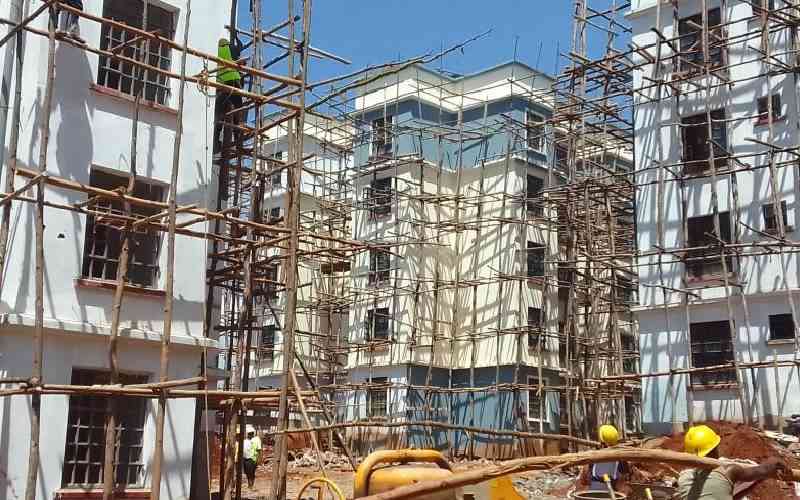A section of Gichugu Affordable Housing Programme in Kianyaga market in Kirinyaga county. The programme is at 87 percent complete and had engaged hundreds of the youth. [Boniface Gikandi]

A section of Gichugu Affordable Housing Programme in Kianyaga market in Kirinyaga county. The programme is at 87 percent complete and had engaged hundreds of the youth. [Boniface Gikandi]
Nearly all economic sectors grew at a slower pace last year, with some such as construction and mining, contracting.
This saw the economy post a sluggish growth at 4.7 per cent in 2024 from 5.7 per cent in 2023. Sectors such as construction, contracted by 0.7 per cent last year from a growth of three per cent in 2023, putting in doubt some of President William Ruto’s pet projects including the affordable housing programme.
The construction sector was last year expected to have received a boost from the housing project to create jobs but also increase consumption of products such as cement and steel.
Nearly all the indicators in the sector were however on the decline. According to the Economic Survey 2025, cement consumption dropped 7.2 per cent while employment registered a downward trend. Credit from commercial banks to the sector also dropped to Sh528 billion last year from Sh602.7 billion in 2023.
“The contraction was reflected in the decline of key inputs such as cement and iron and steel imports in the construction sector,” said the survey, launched on Tuesday by the Kenya National Bureau of Statistics.
“In addition, the number of residential housing units completed by the State Department for Housing (SDHUD) declined from 3,357 units in 2023 to 1,655 units in 2024.”
The National Treasury has significantly increased allocations to the sector with expectations that this will boost the sector and put the government’s affordable housing programme back on track.
In the Budget Estimates tabled in Parliament last year, Treasury has allocated Sh119.6 billion to the State Department for Housing and Urban Development. This is 60.2 per cent higher than the Sh74.66 billion the State Department was allocated last year.
In the Finance Bill 2025, Treasury has proposed lowering the Export and Investment Levy for steel bars used in construction from 17.5 per cent to five per cent, a move expected to play a part in lifting the construction sector. The Bill has however proposed taking away tax exempt status of supplies such as steel and cement to affordable housing projects, which would increase costs for the sector.
The housing programme is perhaps the most visible anchors of Kenya Kwanza’s five prong Bottom Up Economic Transformation Agenda (Beta), with the others being agriculture, health care, Micro, Small and Medium Enterprises Economy and the Digital Superhighway and Creative Economy.
Agriculture registered a slow growth of 4.6 per cent, which is in comparison to a growth of 6.6 per cent in 2023.
The Economic Survey attributed this to varied weather patterns last year, noting that while the “long rains were above-average.. the short rains were below average, leading to mixed performance of the various crops”.
This had the impact of reducing maize production by 6.1 per cent to 44.7 million 90kg bags in 2024 from 47.6 million bags in 2023.
Stay informed. Subscribe to our newsletter
Maize is a staple in Kenya but local production has over the years been unable to meet demand, hence imports to importation to bridge the shortfall. The drop in production last year was despite Kenya kwanza’s subsidizing inputs including feritliser that was expected to increase production.
Other food crops that declined include potato production, which dropped from 2.3 million tonnes to 2.2 million tonnes in 2024. The survey however noted that bean production increased from 9.6 million bags in 2023 to 10 million bags in 2024. Over the next financial year, Treasury has allocated Sh48.25 billion to the State Department for Agriculture, a Sh2.6 billion increase from Sh45.64 billion over the current financial year that ends in June 2025.
The department for livestock production, the other agricultural subsector, has been allocated Sh9.99 billion over the 2025/26 financial year. This is however lower than the Sh11.42 billion it got last year.
Manufacturing, which has for years been tipped to have immense potential but which the country has been unable to tap, grew 2.8 per cent last year, a faster growth than 2.2 per cent recorded in 2023.
Manufacturing is seen as key to creating jobs and building houses, key for the government Beta Agenda.
The sector’s contribution to GDP declined to 7.3 per cent from 7.5 per cent in 2023. Manufacturing has been in an ambitious plan to increase its contribution to the GDP t0 20 per cent by 2030 but says there is a need for the government to put in an enabling framework for the sector to grow.
The state department for industry, which oversees putting in place a conducive environment for the sector, has been allocated Sh8.68 billion next financial year, an increase from Sh7.3 billion it had been allocated over the current financial year.
The information and communication sector recorded a decelerated growth of seven per cent last year. This is compared to a growth of 10.3 per cent in 2023. The ICT sector is key in developing the digital superhighway and creative economy.